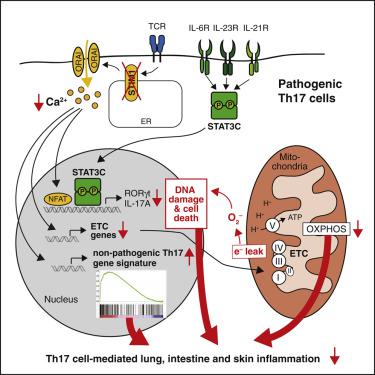当前位置:
X-MOL 学术
›
Cell Metab.
›
论文详情
Our official English website, www.x-mol.net, welcomes your
feedback! (Note: you will need to create a separate account there.)
Calcium Signaling Controls Pathogenic Th17 Cell-Mediated Inflammation by Regulating Mitochondrial Function.
Cell Metabolism ( IF 27.7 ) Pub Date : 2019-02-14 , DOI: 10.1016/j.cmet.2019.01.019 Ulrike Kaufmann 1 , Sascha Kahlfuss 1 , Jun Yang 1 , Elitza Ivanova 1 , Sergei B Koralov 1 , Stefan Feske 1
Cell Metabolism ( IF 27.7 ) Pub Date : 2019-02-14 , DOI: 10.1016/j.cmet.2019.01.019 Ulrike Kaufmann 1 , Sascha Kahlfuss 1 , Jun Yang 1 , Elitza Ivanova 1 , Sergei B Koralov 1 , Stefan Feske 1
Affiliation

|
Pathogenic Th17 cells play important roles in many autoimmune and inflammatory diseases. Their function depends on T cell receptor (TCR) signaling and cytokines that activate signal transducer and activator of transcription 3 (STAT3). TCR engagement activates stromal interaction molecule 1 (STIM1) and calcium (Ca2+) influx through Ca2+-release-activated Ca2+ (CRAC) channels. Here, we show that abolishing STIM1 and Ca2+ influx in T cells expressing a hyperactive form of STAT3 (STAT3C) attenuates pathogenic Th17 cell function and inflammation associated with STAT3C expression. Deletion of STIM1 in pathogenic Th17 cells reduces the expression of genes required for mitochondrial function and oxidative phosphorylation (OXPHOS) but enhances reactive oxygen species (ROS) production. STIM1 deletion or inhibition of OXPHOS is associated with a non-pathogenic Th17 gene expression signature and impaired pathogenic Th17 cell function. Our findings establish Ca2+ influx as a critical regulator of mitochondrial function and oxidative stress in pathogenic Th17 cell-mediated multiorgan inflammation.
中文翻译:

钙信号传导通过调节线粒体功能来控制致病性Th17细胞介导的炎症。
致病性Th17细胞在许多自身免疫和炎性疾病中起重要作用。它们的功能取决于T细胞受体(TCR)信号传导和激活信号转导子和转录激活子3(STAT3)的细胞因子。TCR的参与激活了基质相互作用分子1(STIM1)和钙(Ca2 +)通过Ca2 +释放激活的Ca2 +(CRAC)通道流入。在这里,我们表明,在表达STAT3(STAT3C)过度活跃形式的T细胞中消除STIM1和Ca2 +内流会减弱致病性Th17细胞功能和与STAT3C表达相关的炎症。致病性Th17细胞中STIM1的缺失会降低线粒体功能和氧化磷酸化(OXPHOS)所需的基因表达,但会增加活性氧(ROS)的产生。STIM1缺失或对OXPHOS的抑制与非致病性Th17基因表达特征和致病性Th17细胞功能受损有关。我们的发现将Ca2 +涌入确定为致病性Th17细胞介导的多器官炎症中线粒体功能和氧化应激的关键调节剂。
更新日期:2019-02-14
中文翻译:

钙信号传导通过调节线粒体功能来控制致病性Th17细胞介导的炎症。
致病性Th17细胞在许多自身免疫和炎性疾病中起重要作用。它们的功能取决于T细胞受体(TCR)信号传导和激活信号转导子和转录激活子3(STAT3)的细胞因子。TCR的参与激活了基质相互作用分子1(STIM1)和钙(Ca2 +)通过Ca2 +释放激活的Ca2 +(CRAC)通道流入。在这里,我们表明,在表达STAT3(STAT3C)过度活跃形式的T细胞中消除STIM1和Ca2 +内流会减弱致病性Th17细胞功能和与STAT3C表达相关的炎症。致病性Th17细胞中STIM1的缺失会降低线粒体功能和氧化磷酸化(OXPHOS)所需的基因表达,但会增加活性氧(ROS)的产生。STIM1缺失或对OXPHOS的抑制与非致病性Th17基因表达特征和致病性Th17细胞功能受损有关。我们的发现将Ca2 +涌入确定为致病性Th17细胞介导的多器官炎症中线粒体功能和氧化应激的关键调节剂。


















































 京公网安备 11010802027423号
京公网安备 11010802027423号